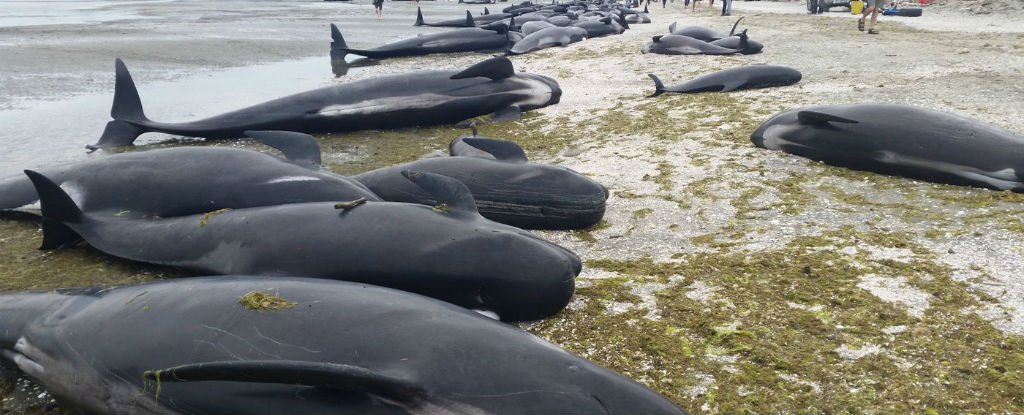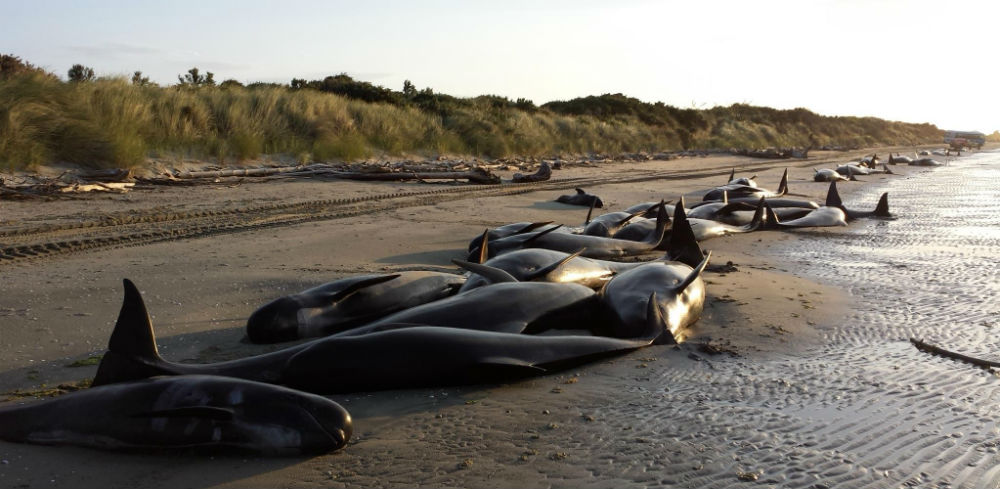
The Exploding Whale Compilation

Posted on 02/14/2017 8:07:59 PM PST by nickcarraway
"It's not very nice getting a 'gut bomb' on your face."
The devastating mass stranding event that saw more than 650 pilot whales beach themselves in New Zealand over the weekend is finally over, with 17 survivors making it back to a large pod of more than 200 individuals seen 6 km (3.7 miles) offshore.
But things are just getting started for the clean-up crew, because hundreds of carcasses are now strewn across Farewell Spit beach, and the public has been banned due to fears of spontaneous whale explosions caused by gas build-up.
"These things explode from the stomach, and if you're standing right there, it's not very nice getting a 'gut bomb' on your face," operations manager at the New Zealand Department of Conservation (DOC), Mike Ogle, told Stuff NZ.
"We've never had to deal with 250 carcasses before, and most of them weigh over a tonne."
In what has become one of the biggest mass stranding events in New Zealand history, 416 pilot whales beached themselves on the South Island's Farewell Spit beach on Thursday evening, followed by roughly 240 more that ran aground between the settlements of Puponga and Pakawau late on Saturday.
pilot-whales-nz cetaceans
Of the first group, close to 75 percent had died by the time DOC staff arrived on Friday morning. Better news came from the second group - most of which managed to refloat themselves on Sunday night's high tide, and the 17 live whales that remained stranded were successfully rescued.
Now that experts have said it's unlikely that a large, nearby pod will follow suit, the DOC is tasked with disposing of the 240 or so carcasses that remain.
And as difficult as shifting hundreds of massive, rapidly decomposing carcasses sounds, that's only the half of it, because whales are known to explode after death, thanks to the gas that gets trapped in their stomachs like a giant balloon.
"They swell up - there's a lot of bacteria going on in their stomach - and the gut actually comes out of the animal and then blows," Department of Conservation (DOC) spokesperson Andrew Lamason told Radio New Zealand.
"This morning, we'll be getting people down there basically poking holes in them, letting the gas out of them. Hopefully that makes them a lot less buoyant and less likely to drift off."
Described as like "popping balloons", the decompression process involves uses different types of knives and special, 2-metre-long (6.5-foot) hypodermic needle to puncture and deflate the carcasses.
For the morbidly curious, here's what a whale explosion looks like:
The DOC is also considering building a fence around them to stop them from washing out to sea and into nearby beaches in Nelson and on the Kapiti coast, Radio New Zealand reports.
As for what will happen to them once the explosion risk is subdued, it's not yet clear, but the DOC announced this morning that they'll likely move the carcasses further up Farewell Spit to the area of the nature reserve that is not open to the public.
The carcasses will then be moved inland to decompose in the dunes.
The first stranding event on Thursday night is thought to be the third largest in New Zealand's history, with 450 stranding themselves in Auckland in 1985, and roughly 1,000 beaching themselves on the Chatham Islands in 1918 - the largest mass stranding event in recorded history, anywhere in the world.
What's most unnerving about the whole situation is that no one has been able to explain it, and it's not just happening in New Zealand - hundreds of whales have been running themselves aground all over the globe for years.
In 2015, 337 dead whales were discovered off the coast of Patagonia in southern Chile - the largest whale stranding of baleen whales to date.
In 2009, 55 false killer whales found themselves stranded on a South African beach, and in 2016, roughly 80 whales beached themselves on the Bay of Bengal coast in India.
That last group was reportedly so disoriented, of the 36 individuals that rescuers managed to refloat, many of them ended up back on the beach.
A number of hypotheses have been proposed to explain the phenomenon, which also affects other species from the cetacean group of aquatic mammals, including dolphins and porpoises.
Previous research has pointed to the Moon's gravitational influence as potentially messing with these animals' ability to navigate the open oceans. Coastal storms and extreme tides around the full and new moon are thought to disorient them and drive them into dangerously shallow waters.
But no one's been able to convincingly link these events to the types of strandings we see, which has led NASA to search elsewhere for an explanation.
Just last week, NASA announced a new investigation into the role of solar storms in mass stranding, seeing as they're known to mess with Earth's magnetic field, and cetaceans use magnetic-field sensing to navigate.
In this case, it might have also been simply the wrong place at the wrong time for the unfortunate animals, with experts noting that Farewell Spit is a particularly difficult place for whales to navigate, as the sand banks reflect sonar poorly.
The first group of whales could have accidentally gotten too close to shore, and then got stranded as the retreating tide left the sandbanks exposed. The second group might have then been attracted by the first group's calls.
"We don't know why the ... pod came in," Daren Grover, general manager of conservation group Project Jonah, told Stuff NZ.
"They may have been picking up some calls from the whales here and come in to respond. It's very unusual, not something we have seen before."
Hopefully, once the remaining carcasses have been sampled, we could get some more clues about this particular event, and maybe get some insight into the overall phenomenon.
"By taking biopsy samples and doing analyses, we're potentially able to isolate the reason for this. It could be as simple as interference with their navigation systems, but that's, once again, theoretical," DOC spokesman Herb Christophers told Radio New Zealand.
"It is thought that because of the nature of this whole Farewell Spit being a very shallow sand spit, it does cause echo-location problems for the whales in finding their way out of that area."
Are pilot whales not good eating?
The last sequence, using dynamite to blow up the whale rates right up there with dropping live turkeys from a helicopter.
I have a tiny bottle of NYE’S (whale) clock oil from the later days of US whaling. New Bedford, Mass. The oil was made from whales or porpoises which had beached and died. Salvaged from already dead animals. Federal law closed them up.
Whale cults, as bad as human cults like Heaven’s Gate.


Instructions here
The Exploding Whale: The Greatest News Broadcast In Television History
https://www.youtube.com/watch?v=XVVW8BferzQ
Whale related products were incredibly useful, but these days who would know what to do with these whales?
There’s material there for at least a thousand wale bone corsets.
I’d stand backa couple hundred yards and pop them with a .308
Disclaimer: Opinions posted on Free Republic are those of the individual posters and do not necessarily represent the opinion of Free Republic or its management. All materials posted herein are protected by copyright law and the exemption for fair use of copyrighted works.